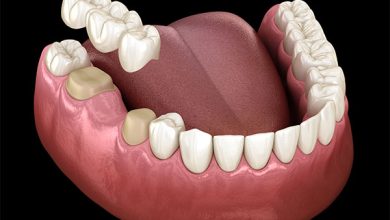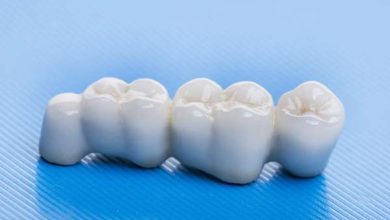What is a Pfm Dental Bridge: Essential Facts Revealed

A PFM (Porcelain Fused to Metal) dental bridge is a restorative dental treatment that involves a metal crown covered with porcelain. This combination of materials provides both durability and a natural appearance, making it a popular choice for replacing missing teeth.
PFM bridges are strong enough to replace multiple missing teeth and can be supported by natural teeth or dental implants. However, PFM restorations may not be as visually appealing as other options due to the difference in color between the metal and porcelain components.
Additionally, the feldspathic porcelain used in PFM crowns can wear opposing teeth at a high rate. Overall, the choice between PFM and zirconia crowns depends on the individual’s needs and preferences.
Overview Of Pfm Dental Bridge
A PFM bridge or Porcelain fused to metal bridge is a restorative dental treatment that includes a cast metal crown with porcelain covering it. The tooth colored ceramic is baked on top of a metallic alloy framework called a coping, ensuring ultimate durability.
A PFM crown is a cap that is cemented over a natural tooth in order to protect it from damage or further decay. PFM crowns provide an excellent balance between resilience and esthetics, as the underlying metal portion of the restorations provides long-lasting durability.
PFM bridges are widely used for both front and back teeth replacements. The metal provides a strong yet malleable density, while the porcelain gives the bridge a natural tooth-like appearance. They are also strong enough to replace multiple missing teeth.
However, there are a few possible drawbacks of PFM bridges. Although they may resemble your natural teeth, the metal covered by an opaque, naturally colored porcelain cover can make the crown noticeable as different from your other teeth and less visually appealing compared to other options. Additionally, PFM crowns may wear opposing teeth at a relatively high rate due to the relatively weak feldspathic porcelain material used for layering.
In terms of materials, PFM bridges have been in use for quite some time. On the other hand, zirconia bridges are gaining popularity due to their high strength and esthetics. It’s important to consider the specific requirements and preferences of each patient when deciding which material is better.
Advantages Of Pfm Dental Bridge
| Advantages of PFM Dental Bridge |
| Ultimate Durability with a metallic alloy framework |
| Tooth-colored ceramic for a natural appearance |
| Excellent balance between resilience and esthetics |
A PFM dental bridge, also known as a porcelain fused to metal bridge, is a restorative dental treatment that involves a cast metal crown with porcelain covering it. This bridge provides ultimate durability as the tooth-colored ceramic is baked on top of a metallic alloy framework called a coping. This framework ensures the strength and longevity of the bridge. The porcelain used in a PFM bridge gives it a natural appearance, seamlessly blending with the surrounding teeth. It also offers an excellent balance between resilience and esthetics. The underlying metal portion of the bridge provides long-lasting durability and strength, while the porcelain gives it a tooth-like appearance. PFM bridges are commonly used for both front and back teeth replacements, providing a strong and aesthetically pleasing solution.
Pfm Vs. Zirconia: Which Material Is Better?
A PFM dental bridge, also known as a Porcelain Fused to Metal bridge, is a restorative dental treatment that involves a cast metal crown with porcelain covering it. The tooth-colored ceramic is baked on top of a metallic alloy framework called a coping, ensuring ultimate durability. PFM crowns provide an excellent balance between resilience and aesthetics, with the underlying metal portion providing long-lasting durability.
In comparison to Zirconia, PFM bridges have certain advantages and disadvantages. While PFM crowns have a natural tooth-like appearance and are widely used for both front and back teeth, they may not be as visually appealing as other options. The porcelain covering the metal may be noticeable as different from natural teeth. Additionally, PFM crowns use metal covered by an opaque, naturally colored porcelain cover, which may affect their aesthetic appeal.
In conclusion, the choice between PFM and Zirconia depends on various factors such as the patient’s dental needs, personal preferences, and budget. It is important for patients to discuss their options with a dental professional to determine which material is best for their specific situation.
How Long Does A Pfm Dental Bridge Last?
A PFM dental bridge, also known as a porcelain fused to metal bridge, is a restorative dental treatment that combines a cast metal crown with a porcelain covering. This bridge provides ultimate durability and a natural tooth-like appearance, making it a popular choice for replacing missing teeth.
Its lifespan can vary, but with proper care, it can last for many years.
A PFM Dental Bridge, or Porcelain Fused to Metal Dental Bridge, is a restorative dental treatment that involves a cast metal crown with porcelain covering it. The tooth-colored ceramic is layered on top of a metallic alloy framework called a coping, providing the bridge with ultimate durability. PFM crowns provide an excellent balance between resilience and aesthetics, as the underlying metal portion provides long-lasting durability, while the porcelain gives the crown a natural tooth-like appearance. The expected lifespan of a PFM Dental Bridge can vary depending on several factors. These include the oral hygiene habits of the patient, the quality of the materials used in the bridge, the skill of the dentist in placing the bridge, and the patient’s diet and lifestyle choices. Proper care and maintenance, such as regular brushing and flossing, avoiding hard foods and habits like teeth grinding, and regular dental check-ups, can help extend the lifespan of a PFM Dental Bridge. However, it is important to note that PFM bridges may have some drawbacks. While they can be durable and esthetically pleasing, they may not be as visually appealing as other options, as the metal covered by an opaque, naturally colored porcelain may be noticeable as different from natural teeth. Additionally, the feldspathic porcelain used in PFM crowns can wear opposing teeth at a high rate. Patients should consider these factors when deciding between a PFM bridge and other materials like zirconia.Disadvantages Of Pfm Dental Bridge
|
A PFM bridge or Porcelain fused to metal bridge is a restorative dental treatment that includes a cast metal crown with porcelain covering it. The tooth colored ceramic is baked on top of a metallic alloy framework called a coping, ensuring ultimate durability. Although PFM restorations look similar to your natural teeth, they aren’t perfect. PFM crowns use metal covered by an opaque, naturally colored porcelain cover. As a result, the crown will likely be noticeable as different from your other teeth and not as visually appealing as other options. |
|
A PFM bridge may have a noticeable appearance compared to natural teeth due to the use of metal and porcelain combination. While the metal provides strength and durability, the porcelain covering may not perfectly match the color and translucency of natural teeth, making the restoration stand out. |
|
Potential drawbacks of using metal and porcelain combination Using a metal and porcelain combination in a PFM bridge can have potential drawbacks. The metal portion of the restoration can be visible at the gum line, creating a dark line that is noticeable when smiling. Additionally, the porcelain may wear down over time, revealing the metal underneath, further affecting the aesthetic appeal of the bridge. |
|
Other alternatives to consider for a more visually appealing result If the noticeable appearance of a PFM bridge is a concern, there are other alternatives to consider for a more visually appealing result. Zirconia bridges are a popular option as they are metal-free and offer excellent aesthetics. Additionally, all-ceramic bridges can provide a natural-looking result without the use of metal. Consulting with your dentist will help you determine the best treatment option for your specific needs and desired outcome. |

Credit: www.smiledentalcenterct.com
Frequently Asked Questions On What Is A Pfm Dental Bridge
How Long Does A Pfm Bridge Last?
A Porcelain Fused to Metal (PFM) bridge can last for a long time due to its ultimate durability. The bridge includes a cast metal crown with porcelain covering, providing both strength and aesthetic appeal. PFM crowns are an excellent choice for replacing multiple missing teeth and can be supported by dental implants.
What Are The Disadvantages Of Pfm Bridges?
Disadvantages of PFM bridges include a less visually appealing appearance compared to other options, as the metal underlying the porcelain may be noticeable. PFM crowns can also wear opposing teeth at a higher rate. Additionally, PFM restorations may not be as aesthetically pleasing as other materials.
What Is The Survival Rate For Pfm Bridge?
The survival rate for a PFM bridge is generally high, with a long-lasting durability due to its metal framework and porcelain covering. However, it is important to note that PFM restorations may not be as visually appealing as other options, as the metal underlay and opaque, naturally colored porcelain can make the crown appear different from natural teeth.
Which Is Better Pfm Or Zirconia?
PFM (Porcelain Fused to Metal) crowns are durable, but the porcelain can wear down opposing teeth quickly. On the other hand, zirconia crowns offer better aesthetics and are more resistant to wear. In terms of material, zirconia is generally considered better than PFM.
However, it’s best to consult with your dentist to determine the right choice for your specific needs.
Conclusion
To wrap up, a PFM dental bridge is a restorative treatment that involves a metal crown with a porcelain coating. This combination of materials provides both strength and aesthetic appeal, making it a popular choice for replacing missing teeth. While PFM bridges may not be as visually appealing as other options, they offer durability and longevity.
It’s important to consider the individual needs and preferences of each patient when choosing between PFM and other materials like zirconia. Ultimately, consulting with a dental professional will help determine the best option for each unique case.



